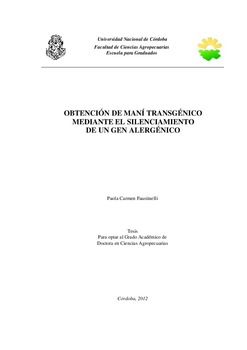| dc.contributor.advisor | Ozias-Akins, Peggy | |
| dc.contributor.author | Faustinelli, Paola Carmen | |
| dc.date.accessioned | 2015-03-26T16:36:58Z | |
| dc.date.available | 2015-03-26T16:36:58Z | |
| dc.date.issued | 2012 | |
| dc.identifier.uri | http://hdl.handle.net/11086/1766 | |
| dc.description | Tesis (Doctor en Ciencias Agropecuarias)--UNC- Facultad de Ciencias Agropecuarias, 2012. | es |
| dc.description.abstract | Argentina se ha consolidado como primer exportador mundial de maní (Arachis hypogaea L.) y Córdoba en la primera provincia productora con un aporte de más del 80% al total nacional. No se cuenta hasta el momento con terapias para tratar reacciones alergénicas producidas por maní en pacientes sensibles y solo se pueden prevenir evitando su consumo. Las semillas de maní contienen 11 proteínas alergénicas, dentro de las cuales se encuentra una de las más alergénicas, la Ara h 2. Si bien en Argentina, el consumo de maní es errático, son objetivos del sector el desarrollo constante de nuevas variedades que le permitan completar la actual oferta comercial, siempre en pos de mejorar la competitividad del país, ofreciendo opciones para nichos de mercados particulares en países donde, para este caso particular, el consumo de maní es generalizado y donde los problemas alérgicos derivados del mismo son notables. El objetivo de este trabajo fue silenciar mediante la técnica de ARN de interferencia, el gen ara h 2 responsable de la presencia de una proteína alergénica en la semilla de maní, lo cual permitió obtener líneas transgénicas potencialmente menos alergénicas. Embriones somáticos de maní variedad Georgia Green fueron transformados vía biobalística, con la construcción diseñada y obtenida en el laboratorio, ara h 2 ARNi, la cual contenía inserto el fragmento ara h 2 en posiciones sentido y antisentido, flanqueando con un segmento del gen GUS lo que permitía formar un rulo ó hairpin. El silenciamiento génico vía ARNi fue exitoso pudiéndose obtener 4 líneas de maní con un contenido reducido y en algunos casos, nulo de proteínas alergénicas del tipo Ara h 2 y por homología, de Ara h 6. En dos sublíneas se produjo una reducción de la proteína Ara h 2 de un ~90% aún suficiente para activar reacciones alergénicas en ratones. En una de las línea transgénica se logró una reducción importante no solo en el contenido de la proteína Ara h 2 sino también de la proteína Ara h 6, y en otra, a pesar de contener múltiples inserciones del transgen, no se detectaron ninguna de las dos bandas correspondientes a estas proteínas por los métodos de inmunodetección utilizados. La obtención de estas líneas ofrecen la posibilidad de mitigar el efecto de las alergias inducidas por maní pudiéndose utilizar en investigaciones que logren evitar las hipersensibilizaciones ó producir reacciones inmunológicas más tardías, permitiendo quizás disminuir el porcentaje de niños afectados. proteínas alergénicas, maní hipoalergénico. | es |
| dc.description.abstract | Argentina strengthened its position as the world leading exporter of peanuts
(Arachis hypogaea L.) and Córdoba as the first producing province that contributes with
more than 80% of the gross national production. So far, there is no therapy to treat
allergenic reactions produced by peanuts in sensitive patients; therefore, the only way of
preventing such reactions is to avoid consumption. Peanut seeds contain 11 recognized
allergenic proteins, among them the Ara h 2 as the most allergenic one. While in
Argentina peanut consumption is erratic, the novelty of this project is based on our
country’s large export capacity. The focus on the development of new hypoallergenic
varieties that complement the existing commercial offer would allow Argentina to
improve its competitiveness, as well as the supply options for particular market niches in
countries where peanut consumption is widespread and the allergic problems are
significant.The objective of this study was to silence one of the most immunodominant
allergens in peanuts, Ara h 2, using RNA interference allowing the recovery of transgenic
lines with a potentially reduced allergenic content.Somatic embryos of Georgia Green
peanut were transformed via biolistics, with the ara h 2 RNAi construction obtained in the
laboratory. The construction contained an inserted ara h 2 gen fragment, in sense and
antisense positions, separated by a GUS gene segment that allowed the formation of a loop
or hairpin. Gene silencing through RNAi was successful, and 4 lines of peanut with
reduced, and in some cases null content of allergenic proteins of the Ara h 2 type and, by
homology of Ara h 6, were obtained. In the B3.3.1 and B3.3.2 sublines, there was a ~ 90%
reduction of the Ara h 2 protein, still enough to activate allergenic reactions in mice. In the
line B4.6.1 transgenic line, there was a decrease in both the content of the Ara h 2 protein
and also in the content of Ara h 6; and in the B11.1.1 line none of the bands could be
detected by Western blot or by immunodetection, despite containing multiple insertions of
the transgene,.The acquisition of these lines with a partial or total reduction of the Ara h 2
and/or Ara h 6 proteins could mitigate the effect of peanut-induced allergies. Although a
hypoallergenic peanut could not be obtained, these developments foster further research to
obtain peanuts varieties that avoid hypersensitization or which produce delayed immune
reactions, resulting at the end in a decreased percentage of affected children. | en |
| dc.format.extent | 62 h. : ilustración color | |
| dc.language.iso | spa | es |
| dc.rights | Atribución-NoComercial-SinDerivadas 2.5 Argentina | * |
| dc.rights.uri | http://creativecommons.org/licenses/by-nc-nd/2.5/ar/ | * |
| dc.subject | Arachis hypogaea | es |
| dc.subject | RNA | es |
| dc.subject | ARN | es |
| dc.subject | Maní | es |
| dc.subject | Plantas transgénicas | es |
| dc.title | Obtención de maní transgénico mediante el silenciamiento de un gen alergénico | es |
| dc.type | doctoralThesis | es |





